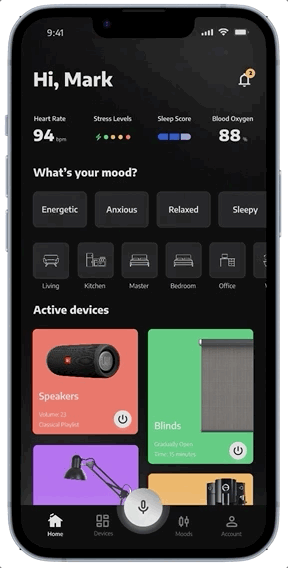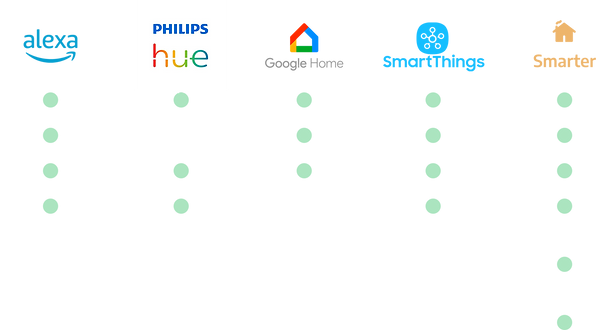
Timeline:
4 weeks
My Role:
UX/UI designer from conception to delivery.
Team:
Individual Project
Software:
Figma, Adobe Photohop,
Adobe Illustrator
PROBLEM
How can we help smart home devices better understand our needs and anticipate our preferences?
An increasing number of households are utilizing smart technology to simplify life using automation features. But as we focus on making these automations fit our preferences, we should ask: Do these innovations truly improve our lives, or is there more to them that we haven't fully understood yet? This line of thought has led me to wonder whether the products on the market are actually "smart," effectively enhancing users' daily surroundings.
SOLUTION
By using health metrics.

Aligning user moods with home environment :
Creating a mood-centric homepage by enabling easy navigation and control based on individual mood.
Clear accessibility for modifying device settings and ensuring effortless customization aligned with user needs.
Smart health metric triggers:
Creating moods using personal data as triggers from smart devices for a regulated home atmosphere.
Use of health metrics triggers to program device settings for an enhanced the living space and a better lifestyle.


Anticipated enhanced living:
Real-time health data monitoring and analysis.
Rapid solutions for optimal living: Instant proposals to enhance the living environment based on analyzed health data.
SURVEY
The main impact of smart home devices on the participants was centred around daily convenience.
To initiate the project, I created a Google Forms survey to gather quantitative data on the demographic profile of individuals currently using home smart devices. The survey aimed to explore their daily frequency routines usage, the impact of smart devices on their lives, and the devices used to interact with the smart technology.

Occasionally
38%
Daily
62%

Convenience
52%
Security
16%
Energy Consumption 12%
Other
3%
Monitor their homes
17%

Laptop
5%
Tablet
14%
Phone
78%
Watch
3%
Current home app usage frequency
Smart home devices adoption reasons
Types of devices used for control
INTERVIEW
My interviewees expressed their desire for smart devices to comprehend their individual needs and enhance their home environment.
The objective of conducting interviews was to gain insights into how smart home devices effectively improve people's lifestyles, identify patterns of usage, as well as understand the challenges they encounter and the feature gaps in the devices.
"I wish it could just understand what I would like on and off, without me have to think about it"
Jennifer
"Having established favorite preferences would help me remember what works best for me."
Louis
“Sometimes turning on multiple devices from my app can be time-consuming.”
Kevin

MAIN INSIGHT
Smart devices should be able to intelligently suggest solutions, enhancing home comfort by understanding individual moods and preferences.
Based on the trends identified in the affinity map, I was able to identify three main pillars to achieve the objective of an enriched living experience that is truly smart and offers an enhanced user engagement.

Understanding human moods to enhance comfort:

Pre-set preferences for faster interactions:

Enhanced usability for all: ensuring accessibility
COMPETITIVE ANALYSIS + GAP
The competitors lack a system that understands human moods and offers users choices for improving their daily routine.
While keeping the above findings in mind, I analyzed the four most popular apps surrounding the smart home space. I found that none of them had this aspect of analyzing human moods and patterns to help them enhance their living environment. This then became my opportunity for a proposed solution.
Automation Features
Manual Setup
Voice Assistant
Time Triggers
Geo-Fence Location
Personalized to Individual Moods
Real-Time Suggestions

IDEATION
Towards a truly smart living: Leveraging health metrics from smartwatches to understand human needs and emotions.
I embarked on a brainstorming journey to discover the most effective approach to comprehend and analyze the relationship between human needs and emotions, with the goal of creating an improved living environment.
By exploring medical studies in the national library of medicine, I deduced that our varying moods can be identified through health metrics collected by our smartwatches.
Leveraging this insight, the smart home system can utilize the natural health data from users' phones or watches to assess their moods to propose better ambiance alternatives and optimize their living environment, thereby achieving a truly smarter home system.

PAPER WIREFRAMES
My Paper wireframes.



USABILITY STUDY: TESTING AND IMPROVEMENTS
Three major improvements in my design
Usability studies offered valuable insights into the user's perspective while engaging with the app. The mockups of the initial design revealed a lack of emphasis on moods and health metrics. Based on the studies, three primary findings emerged, leading to evident modifications in the app.

Efficient homepage flow:
Prioritize the homepage by placing more emphasis on mood and location selection.

Enhanced mood automation visuals:
Incorporating more visual UI cards to ensure accessibility and easy comprehension for all.

Vibrant colors for enhanced accessibility
Utilizing colors that pop out ensures easier understanding and accessibility for all users.
FINAL SCREENS
The final product

Smart notifications:
Real-time notifications for environment enhancements and ambiance suggestions based on health metrics assessment.
Mood-centric home page:
Prioritizing mood-related controls for quick and easy ambiance adjustments to your home spaces.
Providing effortless device tuning to adapt preset automations based on your present mood.


Seamless manual device control:
Easily categorize and control devices by room or type for quick and efficient usage.
User-friendly and accessible interface by leveraging large and clear cards to aid navigation.
Simplified mood automation:
Effortlessly add and modify device actions based on health conditions.
Assign actions to smart device families to easily setup mood automations.


Customizing device preferences:
Personalized device management to suit individual preferences.
Intuitive and user-friendly design for seamless navigation
Smartwatch mood manager:
Easily receive and handle moods via your smartwatch.
Conveniently control moods remotely, ensuring accessibility from any location.


Device control at your fingertips:
Effortlessly control and adjust devices directly from your watch.
Enjoy maximum ease and convenience in device control for a stress-free experience.
STYLE GUIDE
The style guide






